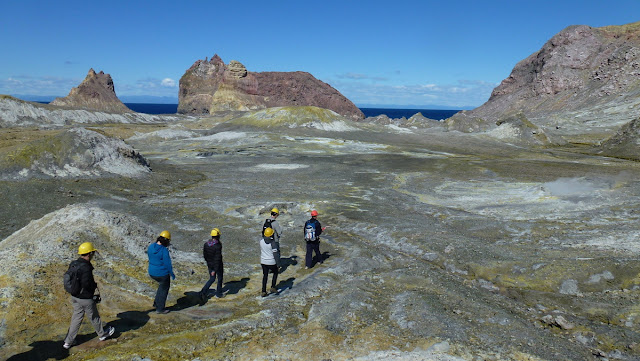New Zealand is the perfect country to map, not only because of all the free data available - it also has a very interesting topography, above and below the sea surface. Actually, around 95 percent of New Zealand’s territory is under water. So I wanted to start off my mapping tour by creating a seafloor map of New Zealand.
You can get bathymetry data (underwater depth) from the National Institute of Water and Atmospheric Research (NIWA). The dataset covers New Zealand's Exclusive Economic Zone and is free to use for non-commercial purposes (terms and conditions). This page describes how the data was collected. I downloaded the “NZ 250m ESRI ASCII grid 530Mb” version of the dataset.
The zip containes two files, RegionalBathymetry2008.asc and RegionalBathymetry2008.prj. The first file contains the actual data in an ASCII grid format. The last file contains information about the projection used, and if you open this file in a text editor it will show you this information:
You can use the gdalinfo command to obtain more information about the dataset:
gdalinfo -mm RegionalBathymetry2008.asc
The red area shows the extent of the dataset. The yellow lines show the equator and the central meridian (100° east longitude). The pin is located at the origin of the coordinate reference system (0, 0). The black line is at 41° south latitude, where we have true scale (250 meters per pixel). The resolution will be higher further south, and lower as we move north.
To make the calculations easier to follow, I’m going to crop the dataset a bit with gdal_translate:
gdal_translate -projwin 4800000 -2100000 7800000 -5900000 -a_ullr 4800000 -2100000 7800000 -5900000 -co compress=lzw RegionalBathymetry2008.asc nz-bathymetry.tif
This command will create a dataset that has a size of 12,000 x 15,000 pixels within an area of 3,000,000 x 3,800,000 meters (3,000 x 3,800 km). The resolution is still 250 meters per pixel.
 |
| On my way to Whakaari / White Island, New Zealand’s only active marine volcano. Why is it there and what's hiding below the surface? |
The zip containes two files, RegionalBathymetry2008.asc and RegionalBathymetry2008.prj. The first file contains the actual data in an ASCII grid format. The last file contains information about the projection used, and if you open this file in a text editor it will show you this information:
Projection MERCATOR Datum WGS84 Spheroid WGS84 Units METERS Zunits NO Xshift 0.0 Yshift 0.0 Parameters 100 0 0.0 /* longitude of central meridian -41 0 0.0 /* latitude of true scale 0.0 /* false easting (meters) 0.0 /* false northing (meters)What does it tell us?
- The dataset is in a Mercator projection. This is clearly not the best map projection to use for New Zealand, but the "official" projection, New Zealand Transverse Mercator 2000 (NZTM2000), is only applicable for the main New Zealand island group.
- It’s using the WGS84 spheroid.
- The coordinate unit is meters.
- The central meridian is not the prime meridian (0° longitude), but 100° east longitude. This is useful, as we avoid problems with the antimeridian (180° longitude), which is passing through the area. I’ll explain these problems in a later blog post.
- The scale of a map using this projection will only be true at 41° south latitude, running through the Cook Strait between the North and South Islands.
You can use the gdalinfo command to obtain more information about the dataset:
gdalinfo -mm RegionalBathymetry2008.asc
Driver: AAIGrid/Arc/Info ASCII Grid Files: RegionalBathymetry2008.asc RegionalBathymetry2008.prj Size is 12115, 15391 Coordinate System is: PROJCS["unnamed", GEOGCS["WGS 84", DATUM["WGS_1984", SPHEROID["WGS 84",6378137,298.257223563, AUTHORITY["EPSG","7030"]], TOWGS84[0,0,0,0,0,0,0], AUTHORITY["EPSG","6326"]], PRIMEM["Greenwich",0, AUTHORITY["EPSG","8901"]], UNIT["degree",0.0174532925199433, AUTHORITY["EPSG","9108"]], AUTHORITY["EPSG","4326"]], PROJECTION["Mercator_1SP"], PARAMETER["latitude_of_origin",100], PARAMETER["central_meridian",0], PARAMETER["scale_factor",1], PARAMETER["false_easting",-41], PARAMETER["false_northing",0], UNIT["METERS",1]] Origin = (4795705.551502100200000,-2067845.457881099500000) Pixel Size = (250.000000000000000,-250.000000000000000) Corner Coordinates: Upper Left ( 4795705.552,-2067845.458) Lower Left ( 4795705.552,-5915595.458) Upper Right ( 7824455.552,-2067845.458) Lower Right ( 7824455.552,-5915595.458) Center ( 6310080.552,-3991720.458) Band 1 Block=12115x1 Type=Float32, ColorInterp=Undefined Computed Min/Max=-3367.677,10069.260 NoData Value=-9999In addition to the projection facts, what does it tell us?
- The image or grid size is 12,115 x 15,391 pixels or cells.
- Each pixel or grid cell covers an area of 250 x 250 meters.
- The extent of the area is defined by four coordinate pairs. The size of the area is 3,028,750 x 3,847,750 meters.
- The image is single band and the debth data is stored as 32-bit floating-point numbers. The maximum depth is 10,669 meters. Interestingly, the minimum depth is -3,368 meters. This tells us that the dataset also contains onshore elevation data, and the lowest number is actually 3.368 meters above sea level. I’m not sure why this is almost 400 meters below the Mount Cook, the highest mountain in New Zealand (3,754 m).
The red area shows the extent of the dataset. The yellow lines show the equator and the central meridian (100° east longitude). The pin is located at the origin of the coordinate reference system (0, 0). The black line is at 41° south latitude, where we have true scale (250 meters per pixel). The resolution will be higher further south, and lower as we move north.
To make the calculations easier to follow, I’m going to crop the dataset a bit with gdal_translate:
gdal_translate -projwin 4800000 -2100000 7800000 -5900000 -a_ullr 4800000 -2100000 7800000 -5900000 -co compress=lzw RegionalBathymetry2008.asc nz-bathymetry.tif
This command will create a dataset that has a size of 12,000 x 15,000 pixels within an area of 3,000,000 x 3,800,000 meters (3,000 x 3,800 km). The resolution is still 250 meters per pixel.
In the nextblog post we’ll start playing with the data.
----
A few more photos from White Island:
----
A few more photos from White Island:
 |
| Towards the crater. |
 |
| The main crater. Where's gollum?!? |
 |
| Walking on the moon. Virtually no vegetation survives the harsh acidic environment. |





Comments